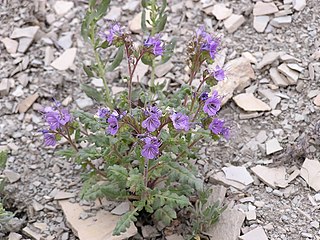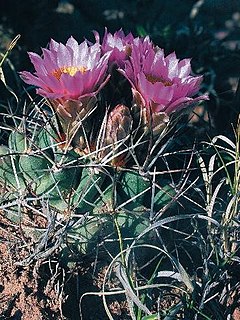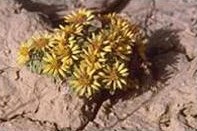
Ferocactus is a genus of large barrel-shaped cacti, mostly with large spines and small flowers. There are about 30 species included in the genus. They are found in the southwestern United States and northwestern Mexico.

Sclerocactus is a genus of cacti. It comprises about 15 species, the exact number depending on the authority. These species are very xerophytic. They are sometimes called 'fishhook cactus' or 'little barrels.'

Harrisia fragrans is a rare species of cactus known by the common names fragrant prickly apple and Caribbean applecactus. It is endemic to Florida, where it is known mainly from St. Lucie County. The plant's habitat has been almost completely consumed by development, leading to its rarity. It is a federally listed endangered species of the United States.

Sclerocactus brevihamatus is a species of cactus known by the common name shorthook fishhook cactus.

Cirsium vinaceum is a rare species of thistle known by the common name Sacramento Mountains thistle. It is endemic to Otero County, New Mexico, in the United States, where it is known only from the Sacramento Mountains. The plant can be found in six canyon systems in a southern section of this mountain range spanning about 32 kilometers. It is rare because it is limited to a specific type of mountain wetland which is both naturally uncommon and threatened by a number of forces. The plant was federally listed as threatened in 1987.

Escobaria robbinsorum is a rare species of cactus known by the common names Cochise pincushion cactus and Cochise foxtail cactus. It is native to southern Arizona in the United States, where it is known only from Cochise County, and northern Sonora in Mexico. There are scattered small occurrences on the north side of the border, and one known population to the south. Because of its rarity and a number of threats to remaining plants, the species was federally listed with a threatened status in 1986.

Escobaria sneedii is a rare species of cactus known by the common names Sneed's pincushion cactus and carpet foxtail cactus. It is native to the Chihuahuan Desert, where it occurs in scattered locations in New Mexico, Texas, and Chihuahua. Some plants occurring in Arizona may be included within this species. Botanical authors do not necessarily agree on the circumscription of this species. Most will agree at this point in the research, however, that there are two varieties of Escobaria sneedii, and that both are rare and endangered. The plant is popular with cactus enthusiasts and dealers because of its often petite size and tolerance for moderately cold climates. They have been overharvested from their natural habitat, the main reason why the two varieties, var. sneedii and var. leei, have been federally listed as endangered and threatened, respectively.

Echinomastus mariposensis is a rare species of cactus known by the common names Lloyd's fishhook cactus, golfball cactus, silver column cactus, and Mariposa cactus. It is native to a small section of territory straddling the border between Brewster County, Texas, in the United States and the state of Coahuila in Mexico. It has been federally listed as a threatened species in the United States since 1979.

Pediocactus sileri is a rare species of cactus known by the common names Siler's pincushion cactus and gypsum cactus. It is native to southwestern Utah and northwestern Arizona in the United States. It is limited to a specific type of soil, individuals are often spaced far apart, and the species is threatened by a number of human activities such as off-road vehicle use, poaching, and uranium mining. This is a federally listed threatened species of the United States.

Pediocactus despainii is a rare species of cactus known by the common names Despain's cactus and San Rafael cactus. It is endemic to the state of Utah in the United States, where it is limited to the San Rafael Swell in Emery County, Utah.

Pediocactus knowltonii is a rare species of cactus known by the common names Knowlton's miniature cactus, Knowlton's pincushion cactus, and Knowlton's minute cactus. It is endemic to San Juan County, New Mexico, in the United States. It is the smallest and rarest species in genus Pediocactus. It is threatened by a number of human activities. It is federally listed as an endangered species of the United States.

Pediocactus peeblesianus is a rare species of cactus known by the common names Navajo pincushion cactus. It is endemic to the state of Arizona in the United States. One subspecies of the plant is federally listed as an endangered species of the U.S.

Phacelia argillacea is a rare species of flowering plant in the borage family known by the common names clay phacelia and Atwood's phacelia. It is endemic to Utah in the United States, where it is known only from one canyon in Utah County. It is "one of Utah's most endangered species"; it is "one of the nation's rarest plants" and is federally listed as an endangered species of the United States.

Glaucocarpum is a monotypic plant genus containing the single species Glaucocarpum suffrutescens, a rare species of flowering plant in the mustard family known by the common names Uinta Basin waxfruit, waxfruit mustard, toad-flax cress, and shrubby reed-mustard. It is endemic to Utah in the United States, where it is known only from Duchesne and Uintah Counties. It is threatened by habitat degradation and destruction. It is federally listed as an endangered species of the United States.

Sclerocactus brevispinus is a rare species of cactus known by the common name Pariette cactus. It is endemic to Utah in the United States, where it is known only from the Pariette Draw, a draw in Duchesne County. It is threatened by a number of processes and human activities.

Sclerocactus glaucus is a rare species of cactus known by the common name Colorado hookless cactus. It is endemic to Colorado in the United States, where it is known only from the area between Grand Junction and Montrose. It is a federally listed threatened species.

Sclerocactus wrightiae is a rare species of cactus known by the common names Wright's little barrel cactus and Wright's fishhook cactus.

Townsendia aprica is a rare species of flowering plant in the aster family known by the common name Last Chance Townsend daisy. It is endemic to Utah in the United States, where it is known from three counties. It faces a number of threats and it is a federally listed threatened species of the United States.

Sclerocactus sileri, the Siler fishhook cactus, is a rare and very small cactus found mostly in mineral-rich desert areas of intermediate elevations, notably in the American states of Utah, Nevada, and northern Arizona.

Physaria tumulosa is a rare species of flowering plant in the family Brassicaceae known by the common name Kodachrome bladderpod. It is endemic to Utah in the United States, where it is known only from Kane County. There is only one known population of this plant made up of scattered occurrences totalling about 20,000 individuals, all within the Kodachrome Basin. The plant is threatened by the loss and degradation of its habitat. It is federally listed as an endangered species. It was previously treated as a subspecies of Physaria hitchcockii.





















